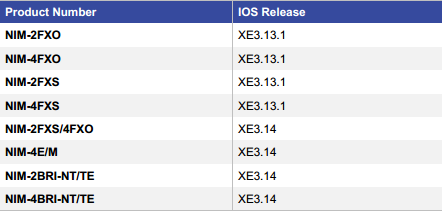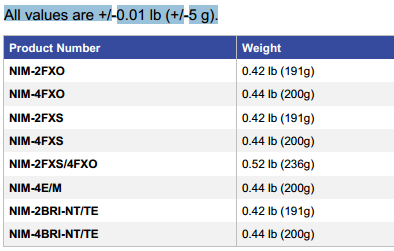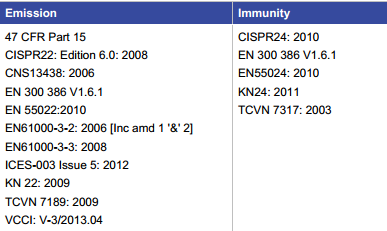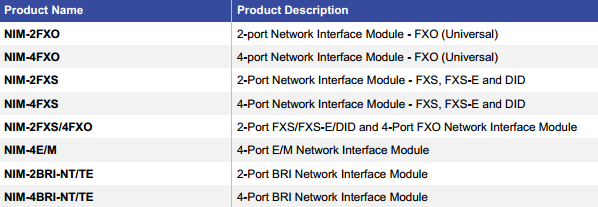
The new Cisco ISR 4000 family is the best one for the large and medium-sized enterprise offices. Also, in the previous article we talked about the benefits you get from migrating to Cisco 4000 Series ISR…Cisco 4451-X vs. Cisco 3945E vs. 3925E vs. Cisco 3945 vs. 3925 Router, the Cisco 4000 Series ISR Gigabit Ethernet WAN Modules and so on…
In this article we continue to tell some info about the network modules for ISR 4000 Family, the new Cisco ISR 4000 Analog Voice Network Interface Modules.
What are these NIM cards? What are they used for? Let’s check more details.
These NIM cards support multiple voice applications on the Cisco ISR 4000 routers.
The Cisco ISR 4000 family hosts the Cisco NIM cards which have evolved from the enhanced high-speed WAN interface card (EHWIC), increasing port density and module capability. Up to three integrated NIM slots on the Cisco ISR 4000 allow for flexible configurations. NIMs support OIR, reducing downtime required for new or replacement modules.
The NIM cards include 2-port and 4-port foreign exchange station (FXS), direct inward dial (DID), foreign exchange office (FXO), a combination of 2-port FXS and 4-port FXO, 4-port ear and mouth (E/M), and 2-port and 4-port basic rate interface (BRI). BRI cards support only voice features.
Note: These NIMs are not supported with Cisco 2900 and 3900 Integrated Services Routers.
Cisco FXO and FXS NIM Types and Feature Comparison
| Part Number | Number of Ports | ISR G2 comparison |
| NIM-2FXO | 2 | VIC2-2FXO |
| NIM-4FXO | 4 | VIC2-4FXO |
| NIM-2FXS | 2 | VIC3-2FXS/DID |
| NIM-4FXS | 4 | VIC3-4FXS/DID |
| NIM-2FXS/4FXO | 6 | VIC2-4FXO and VIC3-2FXS/DID |
| NIM-4E/M | 4 | VIC3-2E/M |
| NIM-2BRI-NT/TE | 2 | VIC2-2BRI-NT/TE |
| NIM-4BRI-NT/TE | 4 | VIC2-2BRI-NT/TE |
Cisco FXS, FXO, E/M and BRI NIMs can be inserted into the NIM slot on the supported Cisco 4000 Integrated Services Routers (ISRs) without powering off the router (support for Online Insertion and Removal).
The new generation Cisco FXO/FXS NIMs, add improvements over the previous WAN Interface Cards (VICs and VIC2s). The FXO, FXS, E/M and BRI NIMs contain an onboard DSP (Digital Signal Processor) and don’t require the router to have dedicated PVDM on the motherboard. The DSP on the voice module is necessary for the voice features. It also provides for echo cancellation of up to 128-ms echo-tail length for demanding network conditions.
The NIMs support:
- Caller Line ID support
- Support for G.711, G.729a & G.726
- Support for G723, iSAC and iLBC is on the roadmap
- Fax detection, pass through and relay (T.38)
- Modem detection and pass through
- DTMF detection
- Echo cancellation
- Voice activity detection
- Comfort noise generation
- RTCP
- Acoustic Shock Protection
- Noise reduction is on the roadmap
- Secured RTP
- RFC4733 Digti Relay
The FXS features include:
- Capable of supporting either FXS or DID functionality
- Configurable long loop ports
- MWI
- Cable detection
The FXO features include:
- Supports both Ground Start and Loop Start modes
- Provide CDR record information
- Support for inter-working with Cisco Unified Call Manager (SCCP), H.323, SIP and MGCP 1.0
- Cable detection
- Overload Protection
FXO port is used to connect to PBX or key system, or to provide off-premise connections to PSTN. Supports battery reversal detection and caller ID. These VICs can be software configured to work in all countries. Also used to connect to analog CAMA trunk to provide dedicated E-911 service (North America only).
FXS port is used to connect directly to phones, fax machines, and key systems. Generates battery polarity reversal and caller ID. VIC3-2FXS-E/DID is designated as an “Off-Premise Extension Lite” product offering. This means that while the module addresses a subset of the off-premise extension applications, it should be noted that the module is not in full compliance for off-premise usage.
DID port is used to provide off-premises DID connection from central office. Serves only incoming calls from the PSTN. Does not support caller ID in DID mode.
The Cisco ISR 4000 routers also supports a NIM carrier card, which converts the SM-X slot into an equivalent NIM slot and can support either one single-wide NIM or a double-wide NIM. This allows the router to support higher port densities.
Cisco IOS-XE Software Release Requirements
The modules are supported on the Cisco 4400 and 4300 ISR routers and require Cisco IOS-XE Software Release 3.13.1. Voice applications require a minimum of the UC technology package, which is optional.
Network Interfaces Specifications
Network Management Features
| Management Feature | |
| Telnet or console | Remote and local configuration, monitoring, and troubleshooting from Cisco IOS-XE Software CLI |
| Simple Network Management Protocol (SNMP) | ● Router and DSU/CSU managed by single SNMP agent; router, DSU, and CSU appear as a single network entity to user
● Standard MIB (MIB II) ● Cisco Integrated DSU/CSU MIB ● RFC 1406 T1 MIB, including Alarm Detection and Reporting |
| SNMP traps | Generated in response to alarms |
Homologation
Standards Cards Have Been Tested to
| NIM-FXO | NIM-FXS | NIM-BRI | NIM-E/M |
| TIA-968-B (USA)
CS-03 (Canada) AS/CA S002 (Australia) AS/CA S003 (Australia) PTC220 (New Zealand) TBR 21 (CE countries) |
TIA-968-B (USA)
CS-03 (Canada) AS/CA S003 (Australia) PTC220 (New Zealand) |
TIA-968-B (USA)
CS-03 (Canada) AS/ACIF S031 (Australia) PTC220 (New Zealand) TBR 3 (CE countries) ITU-T I.430 |
TIA-968-B (USA)
CS-03 (Canada) AS/CA S003 (Australia) |
Compliance
Compliance Standards
More about ordering: If you wanna order a Cisco 4000 NIM card, you can refer to the following ordering information…
More Related Cisco ISR 4000 Topics
Ordering Guide-Optional Items, IOS Software Images and Licenses for the Cisco 4000 Series ISR
Cisco 4400 and 4300 Series Routers/Cisco 4000 Router Family Ordering Guide.







